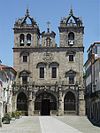
Braga is a city and a municipality, capital of the northwestern Portuguese district of Braga and of the historical and cultural Minho Province. Braga Municipality had a resident population of 201,583 inhabitants, representing the seventh largest municipality in Portugal by population. Its area is 183.40 km2. Its agglomerated urban area extends to the Cávado River and is the third most populated urban area in Portugal, behind Lisbon and Porto Metropolitan Areas.
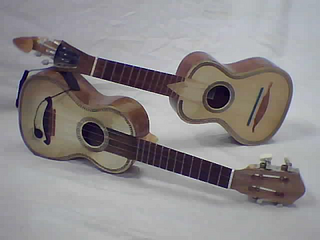
The cavaquinho is a small Portuguese string instrument in the European guitar family, with four wires or gut strings.
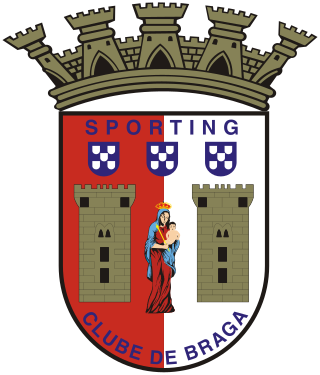
Sporting Clube de Braga, commonly known as Sporting de Braga or just Braga, is a Portuguese sports club from the city of Braga. Best known for the men's professional football team playing in the Primeira Liga, the top flight of Portuguese football at the Estádio Municipal de Braga, it also has departments for athletics, badminton, basketball, beach soccer, billiards, boccia, boxing, esports, futsal, karate, kickboxing, muay thai, swimming, taekwondo and volleyball.
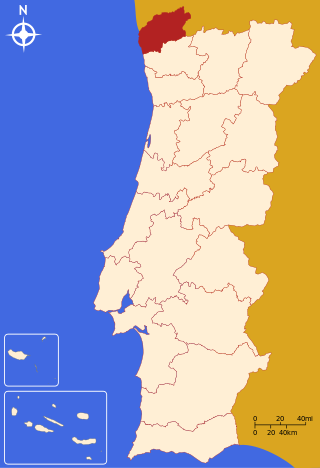
The Viana do Castelo District is a district located in the northwest of Portugal, bordered on the north by Spain (Galicia) and on the south by Braga District. It has an area of 2,255 km2 (871 sq mi) and a population of 252,011 (2006), for a density of 111.8 inhabitants/km2. The district capital is the city of Viana do Castelo.
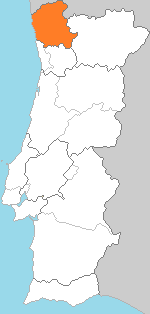
Minho was a former province in Portugal, established in 1936 and dissolved in 1976. It consisted of 23 municipalities, with its capital in the city of Braga. Today, the area would include the districts of Braga and Viana do Castelo. Minho has substantial Celtic influences and shares many cultural traits with neighbouring Galicia, in northwestern Spain. The region was part of the Roman Province and early Germanic medieval Kingdom of Gallaecia. Historical remains of Celtic Minho include Briteiros Iron Age Hillfort, the largest Gallaecian native stronghold in the Entre Douro e Minho region, in north Portugal. The University of Minho, founded in 1973, takes its name from the former province.

The Misericórdia is a church located in Sé, Braga, Portugal.

The Saint Paul Church in Portuguese, Igreja de São Paulo is a Portuguese 16th-century church in Braga, Portugal, dedicated to Saint Paul the Apostle of Jesus.

The Medina Museum is located in Braga, Portugal, in the same building of the Pius XII Museum

The Nogueira da Silva Museum is located in Braga, Portugal.

The D. Diogo de Sousa Museum is located in Braga, Portugal.

The Sanctuary of Our Lady of Sameiro or Sanctuary of Sameiro is a sanctuary and Marian shrine in Espinho, near the city of Braga, Portugal.

The Carmo Church in Portuguese, Igreja do Carmo is a Portuguese 17th-century church in Braga, Portugal, with a Latin cross Floor plan and a single nave.
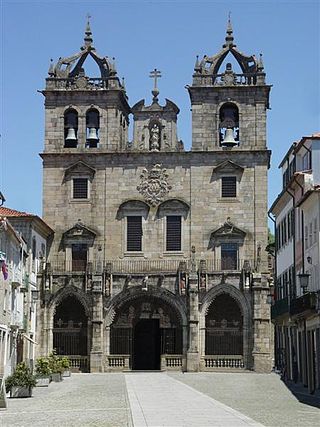
The Cathedral Treasure or Sacred Art Museum is a museum incorporated in the Braga Cathedral in Braga, Portugal.

The Pius XII Museum is located in Braga, Portugal, in the same building of the Museum Medina, as the name from the Pope Pius XII.

The Image Museum or in Portuguese Museu da Imagem is located in Braga, Portugal and is dedicated to photography.

Tebosa is a Portuguese parish, located in the municipality of Braga. The population in 2011 was 1,129, in an area of 2.59 km².

The Cávado River is a river located in northern Portugal.

The Holy Cross Church in Portuguese, Igreja de Santa Cruz is a Portuguese 17th century church in Braga, Portugal, dedicated to the Holy Cross.

The District of Porto is located on the north-west coast of Portugal. The district capital is the city of Porto, the second largest city in the country. It is bordered by the Aveiro and Viseu districts to the south, Braga district to the north and Vila Real district to the east.

The rajão is a 5-stringed instrument from Madeira, Portugal. The instrument traces back to the country's regional folk music, where it is used in folklore dances of Portugal in addition to other stringed instruments from the same region.





















